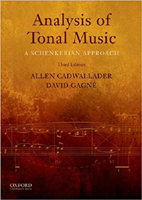Cadwallader, Allen & David Gagne Analysis of Tonal Music: a Schenkarian Approach, 3rd edition
Textbooks - Music Theory, Notation & Writing

-
Cadwallader, Allen & David Gagne
Analysis of Tonal Music: a Schenkarian Approach, 3rd edition
Analysis of Tonal Music: A Schenkerian Approach, Third Edition, is a comprehensive, logically organized introduction to the fundamental principles of Schenkerian technique.Rather than relying on stereotypical models or formulas, authors Allen Cadwallader and David Gagne use specific, memorable compositions to explain structural principles. This approach teaches students how to think about and critically examine music in ways that will inform their understanding and performance of great compositions of Western art music.
Part 1 covers principles fundamental to the study of Schenkerian analysis and includes discussions of melody, counterpoint, bass-line structures, the imaginary continuo, linear techniques, and the essential properties of the Ursatz (fundamental structure). Part 2 presents complete compositions by formal category, beginning with one-part forms; proceeding through binary, ternary, and rondo forms; and concluding with the sonata principle. The book includes more than 200 analytical graphs--some new to this edition--an appendix on graphic notation, and a bibliography.
NEW TO THE THIRD EDITION
- Makes more frequent reference to the principles of strict counterpoint introduced in Chapter 2
- Provides enhanced discussions of harmonic structure and of the imaginary continuo as a tool for analysis (Chapter 3)
- Places greater emphasis throughout Part 2 on Schenker's ideas on musical form
- Reorders Chapter 9 to present the typical formal structures for binary form in a way that parallels Schenker's ideas about form and structure
- Includes a new analysis of a Brahms Intermezzo (a composite ternary form) in Chapter 10
- Features a completely revised concluding chapter that discusses Schenker's ideas on form in relation to common tonal patterns (i.e., structural "paradigms")
-
- Category: Textbooks - Music Theory, Notation & Writing
- Item: 092332
- Grade/Level:
- Price: $117.95
-
(usually ships in 10 to 15 days)
